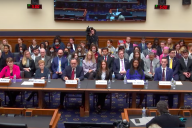You have /5 articles left.
Sign up for a free account or log in.
.png?itok=8f-LETOs)
Rowman & Littlefield
“The oldest and strongest emotion of mankind is fear,” wrote H. P. Lovecraft in the 1920s, “and the oldest and strongest kind of fear is fear of the unknown.” Readers of his treatise Supernatural Horror in Literature were assured that “few psychologists [would] dispute” his claim, although he cited no research to back it up.
Yet this was not mere carelessness. Lovecraft’s speculations were in line with ideas about “the primitive mind” found in the scholarship of the day. Early humankind’s uncomprehending terror of a threat-filled world inspired superstition and religion (more or less synonymous terms in this boilerplate evolutionary narrative). But our species’ advantage in the struggle for survival was the ability to gather and transmit knowledge, however slowly, and thereby develop a degree of understanding and control over natural phenomena. Civilization was a relatively secure island of rational order, of understanding and control over natural phenomena, inconceivable to our cave-dwelling ancestors.
Lovecraft, in defending what he called “a literature of cosmic fear,” accepted this grand narrative in principle while also insisting that the island was a tiny speck in a universe unimpressed by its sovereignty. “Minds sensitive to hereditary impulse,” he wrote with his characteristic eldritch flourishes, “will always tremble at the thought of the hidden and fathomless worlds of strange life which may pulsate in the gulfs beyond the stars, or press hideously upon our own globes in unholy dimensions which only the dead and the moonstruck can glimpse.”
I take it that Arash Javanbakht, a psychiatrist and neuroscientist and director of the Stress, Trauma and Anxiety Research Clinic at Wayne State University School of Medicine, is holding the fort on that tiny island. His book Afraid: Understanding the Purpose of Fear and Harnessing the Power of Anxiety (Rowman & Littlefield) opens by acknowledging fear as “one of the most deeply rooted biological mechanisms that has evolved over hundreds of millions of years in the brains and bodies of animals and humans with one key mission: to increase our chance of survival.” It is hardwired into human physiology in ways it is sometimes possible to override but never to turn off for good. (At least not deliberately: damage to the brain can destroy the capacity for fear, at great danger to the organism.)
But dismissing fear as primitive or celebrating its inescapability are about equally far from his approach. The laboratory and clinical research that Javanbakht discusses is marshaled to understand and mitigate the dangerous aspects of human fearfulness. Real, raw fear “regresses us to a more primitive, rigid, and less flexible level,” he writes, “and rigidity is generally the opposite of creativity.” That said, our capacity to find entertainment in imaginary horrors is a sort of evolutionary luxury—an exercise of the power to feel in control, that “may also put fears and anxieties of modern life into context.”
The author goes over the relevant physiological basics, particularly the role of neurotransmitters and the grounding of what he calls “the fear system” in regions of the brain (the amygdala and hippocampus in particular). The sympathetic and parasympathetic neurons “both have extensive reach to most important organs, and often function opposite to each other in each of these organs.” Responding to perceived threats outside the body, the sympathetic nervous system narrows the behavioral options to fight, flight, or freezing in place, so as not to draw attention. The parasympathetic nervous system “organizes the internal maintenance and metabolic behaviors such as activities of the gastrointestinal system, bladder, and salivation,” all of them “energy-consuming functions that are not a priority during a life-threatening situation when it is better to direct energy, oxygen, and blood away from them.” The parasympathetic system is also involved in shutting down the fight-or-flight response; this causes freezing or fainting. (The evolutionary advantage of fainting is hard to imagine, and it goes unexplored.)
Some fear responses may have a genetic component, as suggested by a study in which 8- to 14-month-old infants were shown mixed pairs of pictures of snakes, frogs and flowers. Their attention went most quickly to the snakes; likewise, they responded more quickly to an angry human face than to a happy one. More interesting, I think, are Javanbakht’s reports on learned fear, including forms that might be called contagious. Pregnant rats given an electrical shock when exposed to the smell of peppermint understandably became fearful of its scent. They were exposed to peppermint again later, while tending to their offspring; the latter had an avoidance reaction to the smell despite never having been shocked. A variety of other experiments show what sound like fear reactions communicated nonverbally between human subjects.
What Lovecraft called “fear of the unknown,” Javanbakht defines, rather, as anxiety—with fear, in the strict sense, being a reaction to known (or at least distinctly perceived) external threats. “Anxiety, on the other hand,” he explains, “is a response to an unknown and vague threat, often has an internal source, and involves a diffuse sense of apprehension.” This distinction in place, the author goes on to pair them together, often enough, as if varieties of a common dynamic; the neurotransmitters involved overlap. And both fear and anxiety have a close and tangled relationship (sometimes as causes and sometimes as responses) to aggression and violence.
Little surprise that Javanbakht finds numerous occasions to connect his field of expertise to recent developments in news from around the world. In particular, the evidence of intergenerational transmissions of fear, anxiety and trauma make for unhappy implications. Yet the author’s tone is almost always energetic, even jaunty. Perhaps that is easier than dwelling at length on the implications of what he’s describing.






.png?itok=WKfQ3Iyu)
.png?itok=tHd8ezfK)
.png?itok=MgfBP_gU)